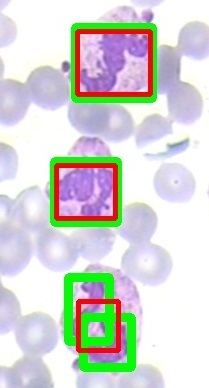This forum is disabled, please visit https://forum.opencv.org
 | 1 | initial version |
Yes, groupRectangles is good to solve your problem.
i can't provide python code but i want to mention some hints
it seems the documentation about the function is confusing.you can use only variant of the function below
void cv::groupRectangles ( std::vector< Rect > & rectList,
std::vector< int > & weights,
int groupThreshold,
double eps = 0.2
)
Python:
rectList, weights = cv.groupRectangles( rectList, groupThreshold[, eps] )
also have a look at faster-non-maximum-suppression-python
 | 2 | No.2 Revision |
Yes, groupRectangles is good to solve your problem.
i can't provide python code but i want to mention some hints
it seems the documentation documentation about the function is confusing.you can use only variant of the function below
void cv::groupRectangles ( std::vector< Rect > & rectList,
std::vector< int > & weights,
int groupThreshold,
double eps = 0.2
)
Python:
rectList, weights = cv.groupRectangles( rectList, groupThreshold[, eps] )
also have a look at faster-non-maximum-suppression-python
 | 3 | No.3 Revision |
Yes, groupRectangles is good to solve your problem.
i can't provide python code but i want to mention some hints
it seems the documentation about the function is confusing.you can use only variant of the function below
void cv::groupRectangles ( std::vector< Rect > & rectList,
std::vector< int > & weights,
int groupThreshold,
double eps = 0.2
)
Python:
rectList, weights = cv.groupRectangles( rectList, groupThreshold[, eps] )
also have a look at faster-non-maximum-suppression-python for an alternative way
 | 4 | No.4 Revision |
Yes, groupRectangles is good to solve your problem.
i can't provide python code but i want to mention some hints
it seems the documentation about the function is confusing.you can use only variant of the function below
void cv::groupRectangles ( std::vector< Rect > & rectList,
std::vector< int > & weights,
int groupThreshold,
double eps = 0.2
)
Python:
rectList, weights = cv.groupRectangles( rectList, groupThreshold[, eps] )
also have a look at faster-non-maximum-suppression-python for an alternative way
EDIT 1:
combined your code and @berak 's answer
see red lines only ( i used the image above)
import cv2
import numpy as np
def draw(rects,color):
for r in rects:
p1 = (r[0], r[1])
p2 = (r[0]+r[2], r[1]+r[3])
cv2.rectangle(img, p1,p2, color,4)
limit_area = 500
x = 0
y = 0
w = 0
h = 0
nuclei = []
count = 0
number_name = 1
img = cv2.imread('e:/t.png')
img = cv2.add(img, 0.70)
img_hsv = cv2.cvtColor(img, cv2.COLOR_BGR2HSV)
mask1 = cv2.inRange(img_hsv, (90,90,0), (255,255,255))
mask2 = cv2.inRange(img_hsv, (70,100,0), (255,255,255))
mask = mask1 + mask2
kernel = np.ones((1,3),np.uint8)
mask = cv2.dilate(mask,kernel,iterations = 2)
mask = cv2.morphologyEx(mask, cv2.MORPH_OPEN, kernel)
mask_blur = cv2.medianBlur(mask,5)
canny = cv2.Canny(mask_blur, 100,300,3)
contours, hierarchy = cv2.findContours(canny,cv2.RETR_EXTERNAL,cv2.CHAIN_APPROX_SIMPLE)
rects = []
for cnt in contours:
if cv2.contourArea(cnt) >= limit_area:
nuclei.append(cnt)
print(cv2.contourArea(cnt))
x, y, w, h = cv2.boundingRect(cnt)
rects.append([x, y, w, h])
rects.append([x, y, w, h])
rects,weights = cv2.groupRectangles(rects, 1, 1.5)
draw(rects, (0,0,255))
cv2.imshow('img', img)
cv2.waitKey(0)
cv2.destroyAllWindows()
